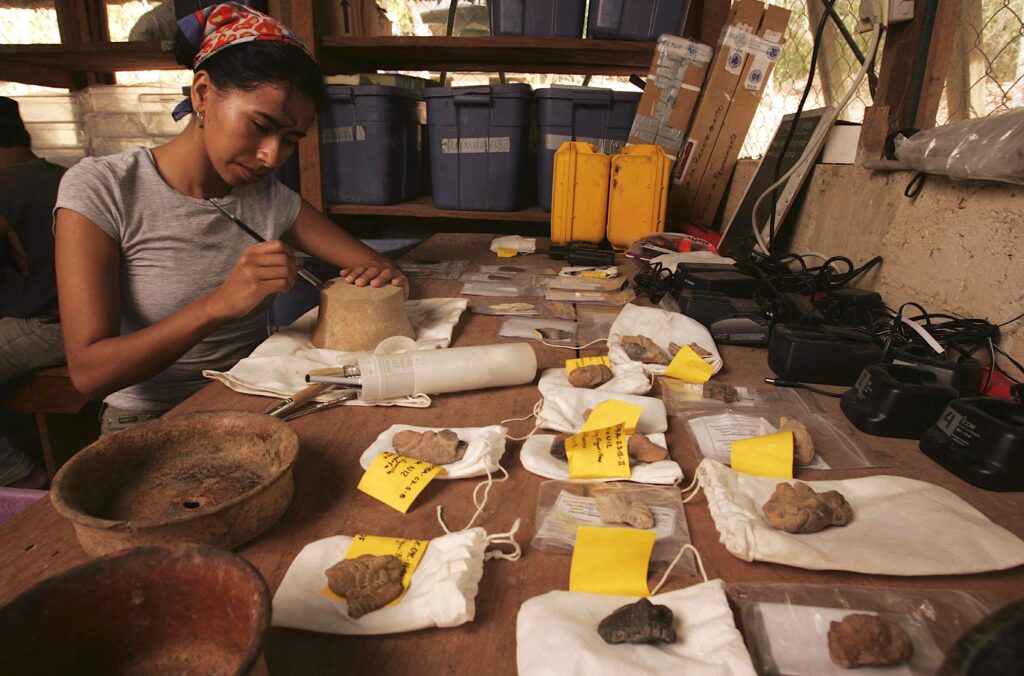What Do Archaeologists Do?

WHAT DO ARCHAEOLOGISTS DO?
Archaeologists study the physical objects, places, and landscapes that humans create, modify, or interact with. Their goal is to learn more about human histories and experiences. Archaeologists investigate the physical traces of human activities, which are sometimes called material culture. These materials can be very recent—such as the objects on someone’s bookshelf or trash from the 1969 Woodstock festival. Alternatively, they can be very old—like the first stone tools from 3.3 million years ago or 45,000-year-old cave paintings in Indonesia.
Sometimes, archaeologists study the smallest traces of human activities, such as the microscopic shapes of domesticated maize starch grains or remnants of meals preserved in the plaque that forms on teeth. They also examine some of the largest, such as the ancient city of Petra in Jordan or Maya pyramids in Mexico.
Above all, archaeologists are concerned with materiality—the actual, literal stuff that makes up our lives. From this stuff, they can gain insights into intangible things, including various cultures’ beliefs about personhood, ancient humans’ relationship to the night, and people’s resilience in the face of environmental changes.
Archaeologists are probably best known for excavating sites, whether they are sifting through the ashes of Notre Dame in the aftermath of the 2019 fire or digging through the 20,000-year-old remains of more than 200 mammoths. Excavation provides a systematic process for revealing and recovering material culture. But it is far from the only method archaeologists use.
They also delve into historical documents, translate ancient hieroglyphs, conduct interviews to learn about a culture’s oral history, and measure tree rings to find evidence of climatic shifts. They might use lidar scanning to uncover ancient sites in jungles or shine laser beams onto soil samples to determine their age.
WHAT TYPES OF ARCHAEOLOGISTS ARE THERE?
In North America, archaeology is considered a field of anthropology. Anthropological archaeologists use a holistic approach to understanding human history, from early origins to the present. Archaeology can also be practiced as part of other fields such as classics, history, religious studies, or even architecture. In these fields, the study of material remains and historical texts provides additional insight into people’s lives. Archaeology outside of North America is often categorized as its own field, independent of anthropology or history.
When you ask an archaeologist what kind of archaeology they practice, they’re likely to respond by saying their work focuses on a specific time, place, or use of a particular method. Historical archaeologists study the making of the modern world—the rise of global capitalism and global networks associated with European expansion and colonialism. Paleoarchaeologists investigate ancient human histories. Zooarchaeologists study animal remains. Archaeobotanists examine plant remains. And bioarchaeologists investigate human remains.
Archaeologists might focus on even more specific methods and locations. For example, maritime archaeologists work at shores, ports, and underwater sites. Digital archaeologists use photography, 3D reconstruction, virtual reality, and other technologies in their research. Mayanists explore Maya heritage, while Andeanists work in the Andes.
In addition, Indigenous archaeology involves work conducted with, for, and by Indigenous Nations. This growing field acknowledges the sovereignty of Indigenous Nations to care for and protect their heritage and incorporates Indigenous perspectives into research. Indigenous archaeology projects are also driven by the needs of Indigenous communities and feature their direct participation.
HOW CAN I WORK IN THIS FIELD?
Though many archaeologists bring their children to work, most people don’t get to experience archaeology until they enter college or university. Professional archaeologists often begin by earning a bachelor’s degree and working as field technicians in cultural resource management, or what is called “compliance archaeology.” Entry-level jobs in this industry are usually paid hourly and may be seasonal. Field technicians perform the field surveys, excavations, and lab analyses that many people associate with archaeology.
Senior cultural resource managers and technicians require experience and professional degrees such as a master’s degree or doctorate. They provide supervisory support on projects and take the lead role in writing reports and consulting with agencies, Tribes, developers, and others in the compliance process.
In addition to formal education, archaeologists require field and lab training. There are a range of volunteer and fee-based field schools and lab training programs that are open to adolescents and adults of all ages. While you can get an entry-level archaeology position after having completed one field season, to be a supervisor you’ll need at least one year of fieldwork experience.
Archaeologists, especially at the master’s or doctoral level, also cultivate one or more specialties. These can include skills in remote sensing, geographic information systems (GIS), and genetics. Alternatively, they might develop a focus on ceramics, stone tools, and other materials-based skills.
HOW DO ARCHAEOLOGISTS WORK WITH CULTURAL HERITAGE?
The first questions archaeologists in any region ask are: Whose heritage am I working with? And what responsibilities come with engaging with these peoples and their belongings and stories?
Obtaining government-issued permits, and often permissions from local affiliated communities, is a must before any archaeological research. To apply for permits, archaeologists must also typically create a plan that clearly outlines research questions and details all the planned procedures, including the potential impacts of the work. Local governments require these plans as a way to protect archaeological heritage for future generations.
Many archaeologists work with the public to spread information about shared national heritage and history. Increasingly, they work alongside local and descendant communities. In fact, in many cases, archaeologists from those communities are leading this work.
Despite Indiana Jones’ admonishment to looters in the film Indiana Jones and the Last Crusade that artifacts “belong in a museum,” museums may not be the best final resting place for ancestors and other items of cultural patrimony. Indy’s exploits are a perfect example of how early archaeology operated as part of imperialism and colonialism at a time when Western nations exploited Indigenous peoples and non-Western nations. Part of this process was the collection of antiquities from around the world, without regard for the rights or perspectives of Indigenous peoples and non-Western nations.
Ask SAPIENS is a series that offers a glimpse into the magazine’s inner workings.
In the U.S., cultural resource laws such as the National Historic Preservation Act provide protection for the “archaeological record”—material traces of past human lifeways. Under these laws, archaeologists are charged with the authority, as the subject matter experts, to evaluate and carry out strategies to preserve cultural sites and heritage. Archaeologists usually excavate and recover information about sites that are in immediate danger of being damaged or removed from their original location.
Excavation, however, is also a destructive practice. Without explicit permission from Native American Tribes, excavation of Native American sites is an infringement on Tribal sovereignty—a Tribe’s right to self-government. As sovereign nations, Tribes have the right to determine for themselves how their cultural resources will be treated and where they will be placed.
The rights of Indigenous peoples to protect their cultural resources and ancestors, however, were not always self-evident and codified by law. In the late 1960s, during the height of the Civil Rights era, protection and repatriation of ancestral materials became a prominent issue for Native American activists. The American Indian Movement and other Native activists in the U.S. hosted sit-ins at archaeological sites. For example, Maria Pearson, a Yankton Sioux, tirelessly advocated for repatriation at development projects and museums in Iowa.
These and other efforts by Native American people and Tribes led to the passage of the Native American Graves Protection and Repatriation Act (NAGPRA) in 1990. This was the first law to finally address the protection and repatriation of cultural resources and ancestors from the perspective of human rights legislation specifically for Native American peoples in the U.S.
Despite fears from some archaeologists that repatriation would somehow end the discipline, repatriation has instead transformed archaeological research into a practice that is done in consultation and collaboration with Indigenous peoples. Still, there are some flaws in the U.S. legal system with regards to repatriation. For example, NAGPRA accounts only for the cultural heritage and ancestors of Native American peoples. There are many other communities that should also be allowed to protect and repatriate their heritage and ancestors, such as the African Burial Ground in New York City.
There is still much repatriation work for museums to do for Native American Tribes and other communities. Furthermore, repatriation efforts must increase in countries where NAGPRA does not apply. These initiatives are part of how archaeology continues to evolve and reflect on its role in helping to heal the harms of the past and present, and to care for heritage into the future.
WHAT CAN YOU DO WITH AN ARCHAEOLOGY DEGREE?
Fewer than 10 percent of practicing archaeologists work as university or college professors or for a museum or archaeology lab. The vast majority of archaeologists work in cultural resource management, or compliance archaeology. Archaeologists in these roles are responsible for conducting archaeology on public lands or in the public’s interest. For example, they may survey and identify sites in the path of road or pipeline construction or seek to limit destruction of these places by documenting them. They may also consult with Indigenous Nations and various descendant groups to ensure their priorities are included in treatment plans to protect cultural heritage.
Cultural resource managers might be employed by a local, state, or federal government to review proposed projects and conduct archaeology on lands the agency supervises. Alternatively, they could work for or operate a contracting firm responsible for assessing and mitigating the impacts of development projects on archaeological heritage.
A growing number of archaeologists in the U.S. and Canada work for and with Tribal Nations and First Nations. Indigenous Nations also employ their own archaeologists and cultural stewards to care for and protect ancestral lands and heritage. In these positions, archaeologists may monitor development projects on ceded and unceded Indigenous lands, work directly for Indigenous Nations’ governments to combat climate-related threats to Indigenous heritage, or work to bring home the missing children who attended historic residential boarding schools. In addition, cultural resource management firms led by Indigenous archaeologists often work independently or in tandem with Tribal governments.
A day in the life of a professional archaeologist is often varied. It may include writing reports, conducting surveys in the field, cataloguing collections, or conducting specialized analyses of cultural belongings made of stone, bone, or other materials. As an archaeologist, you’ll appreciate how the small, forgotten things can tell rich stories about people and our histories. You’ll find yourself working in teams and collaborating with people who are connected to and care deeply about human histories, heritage, and the places we continue to call our homes.






























